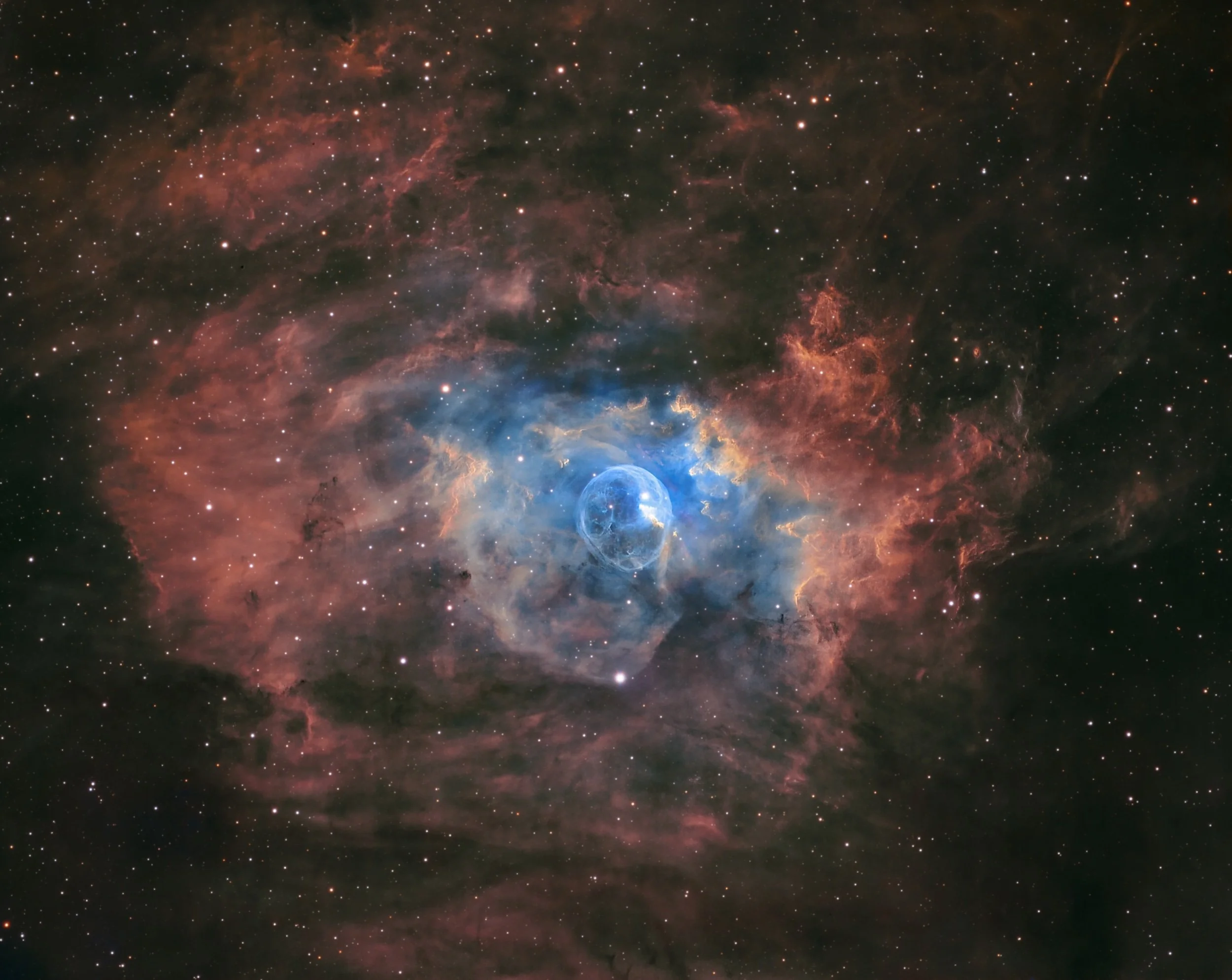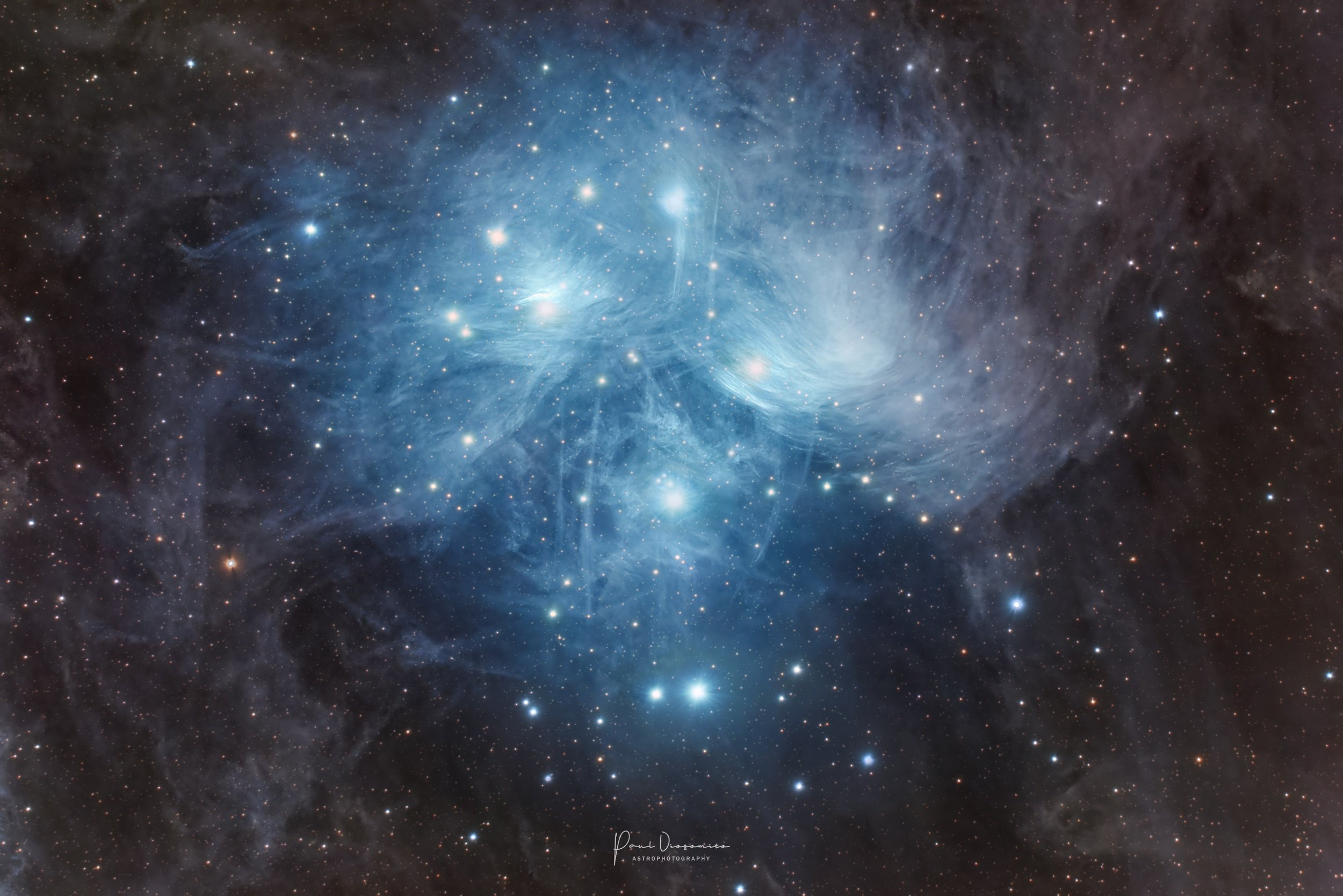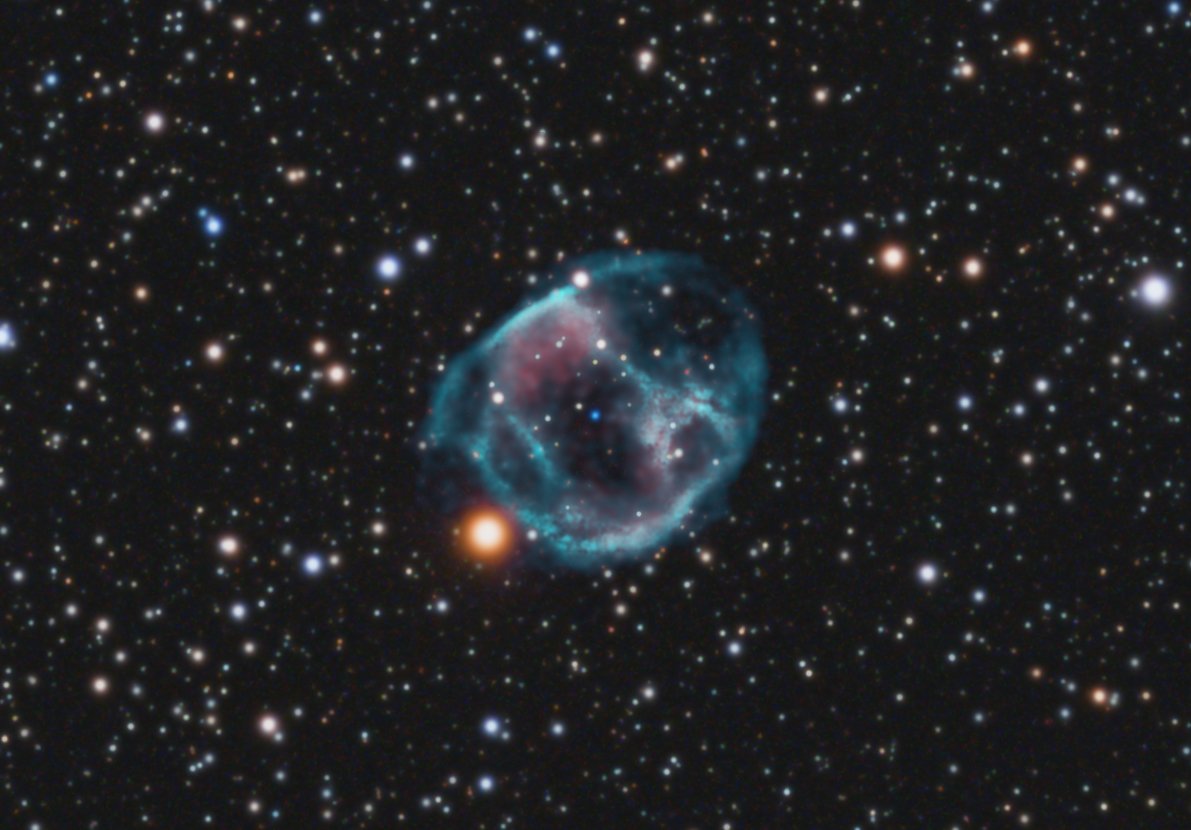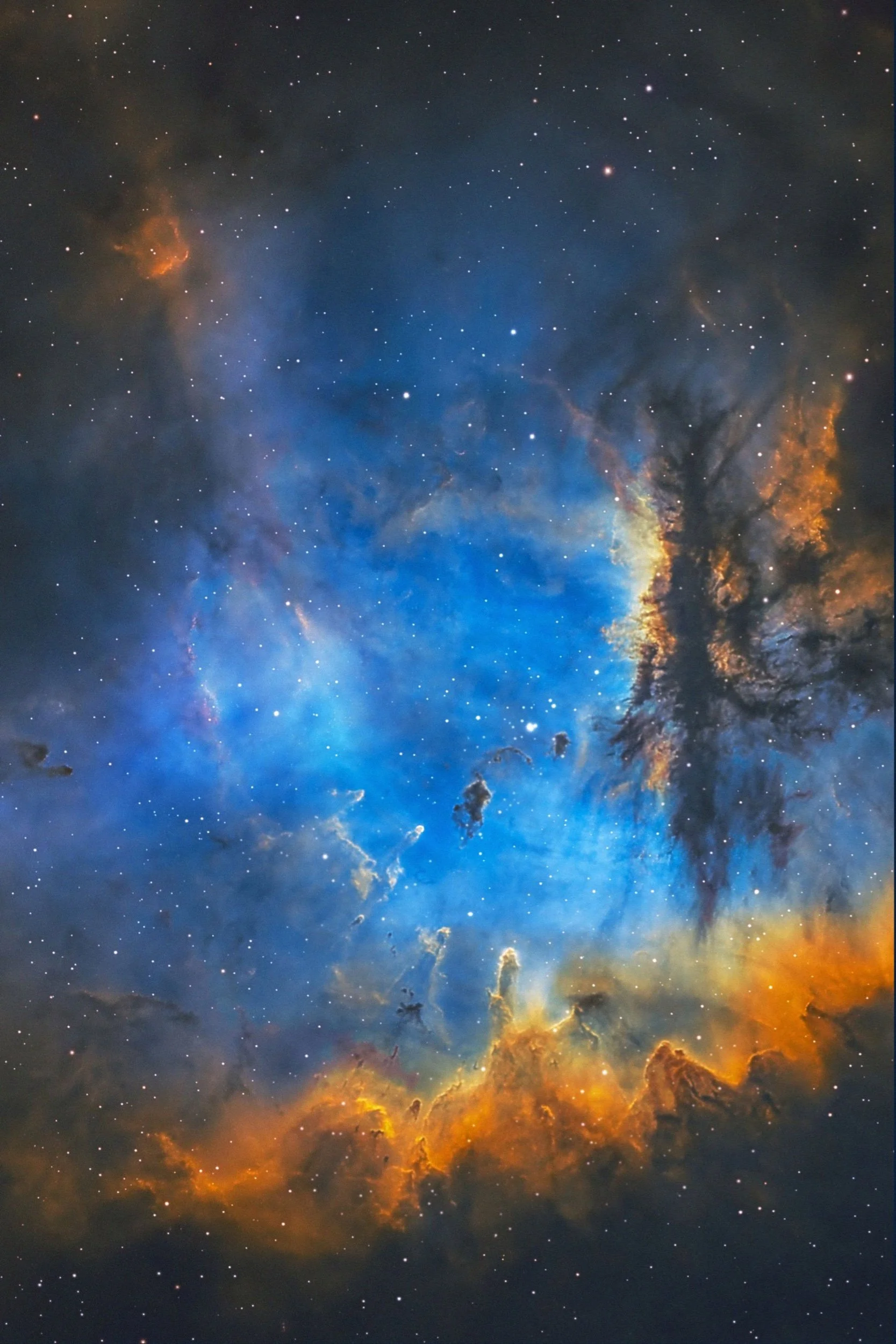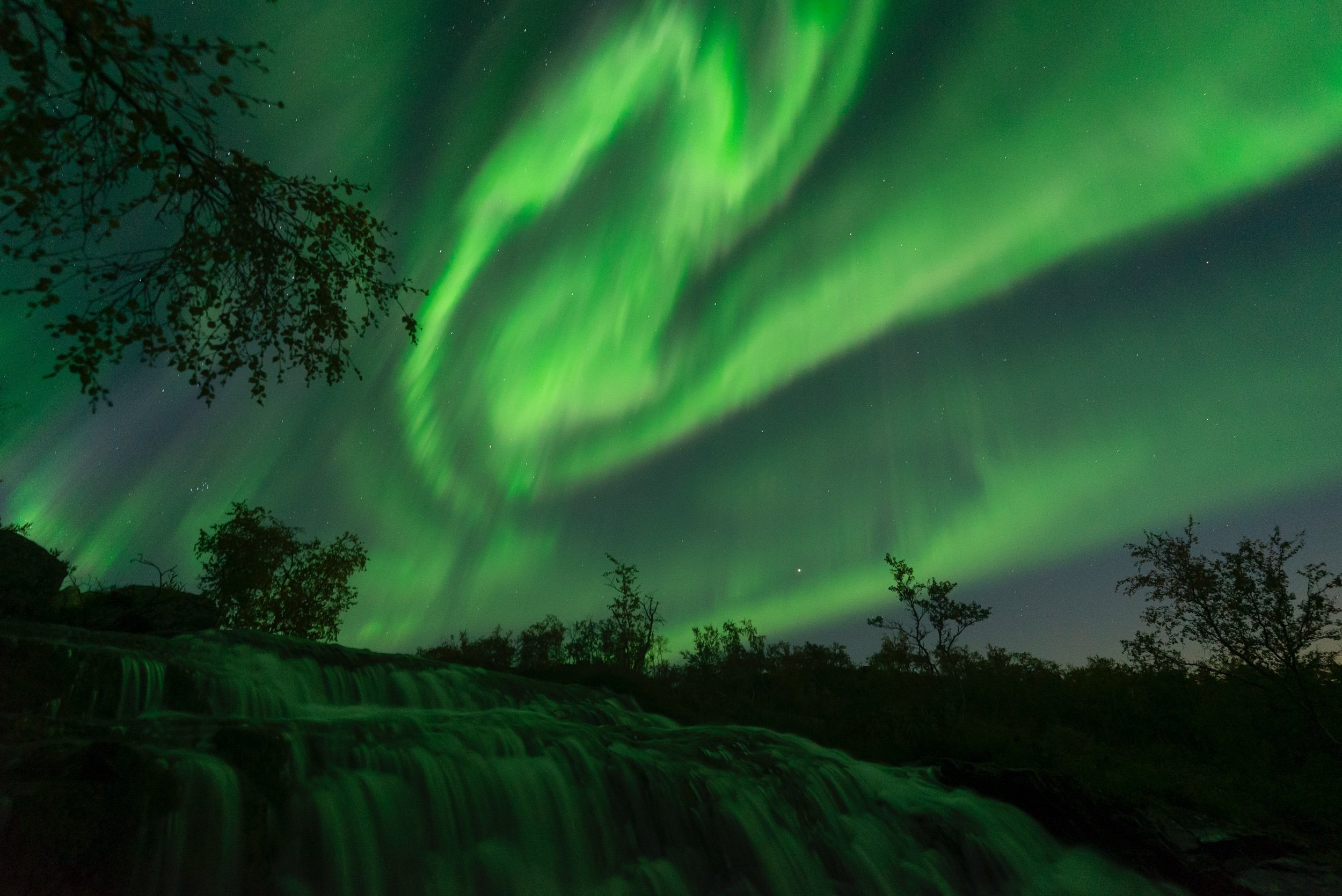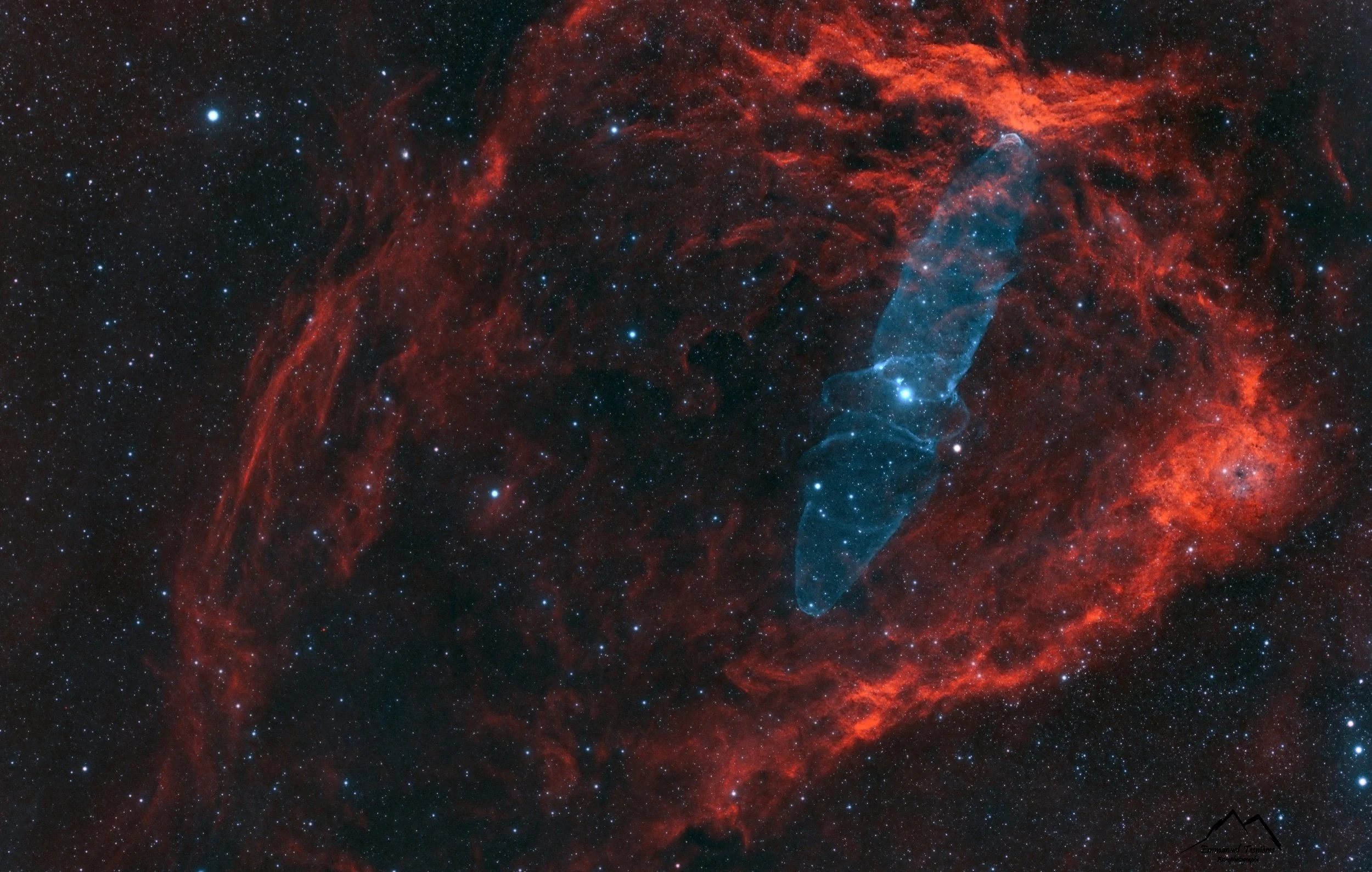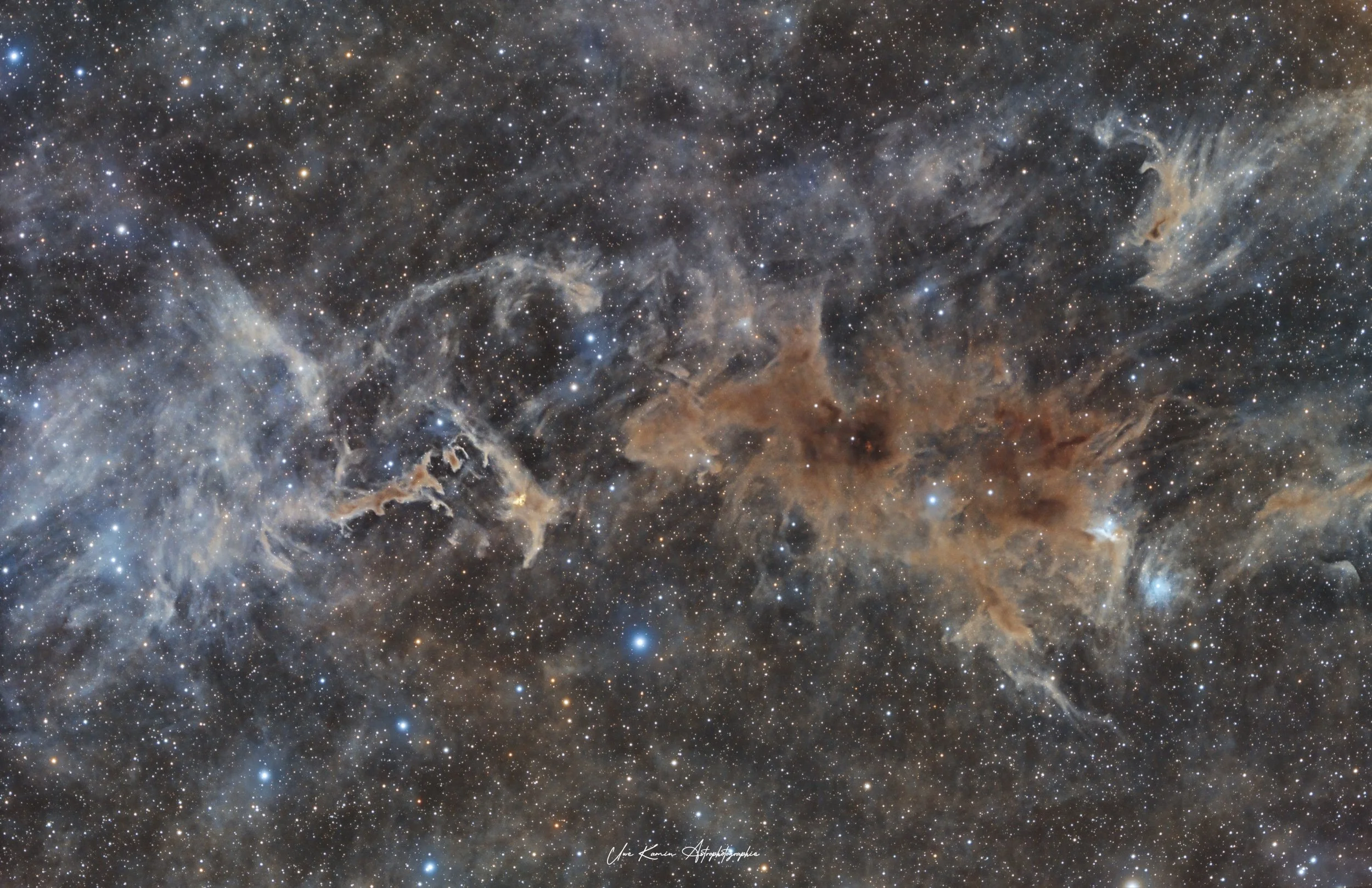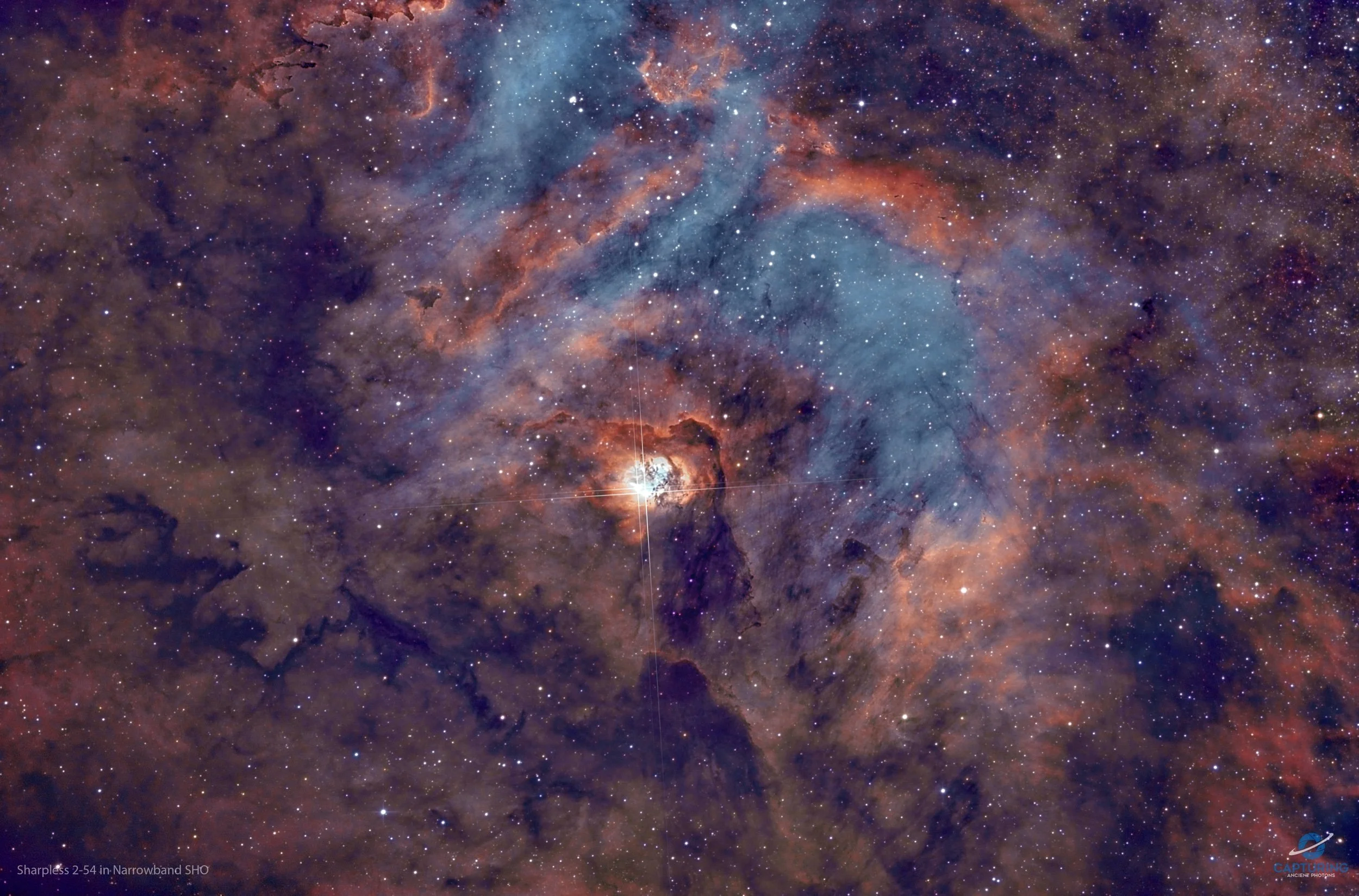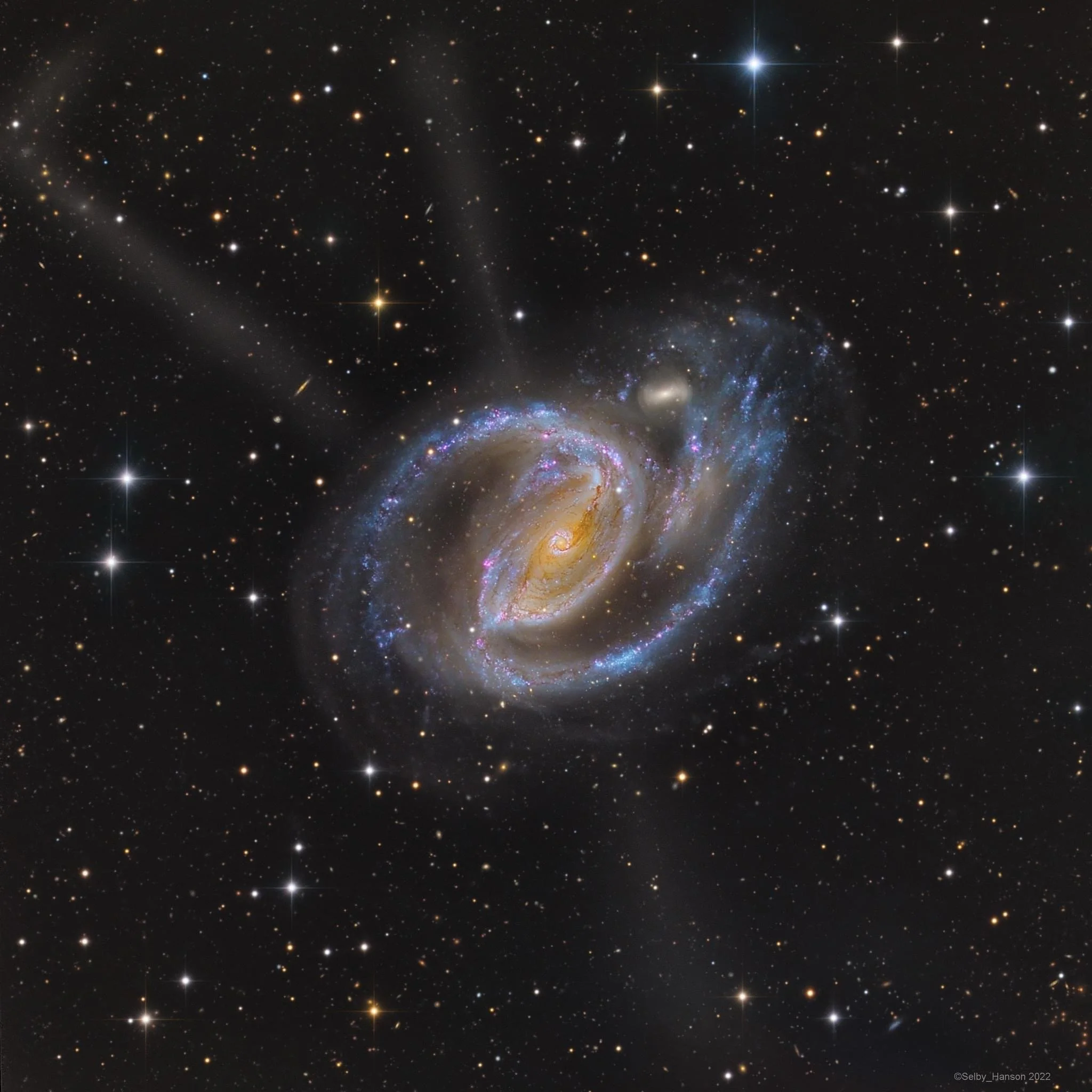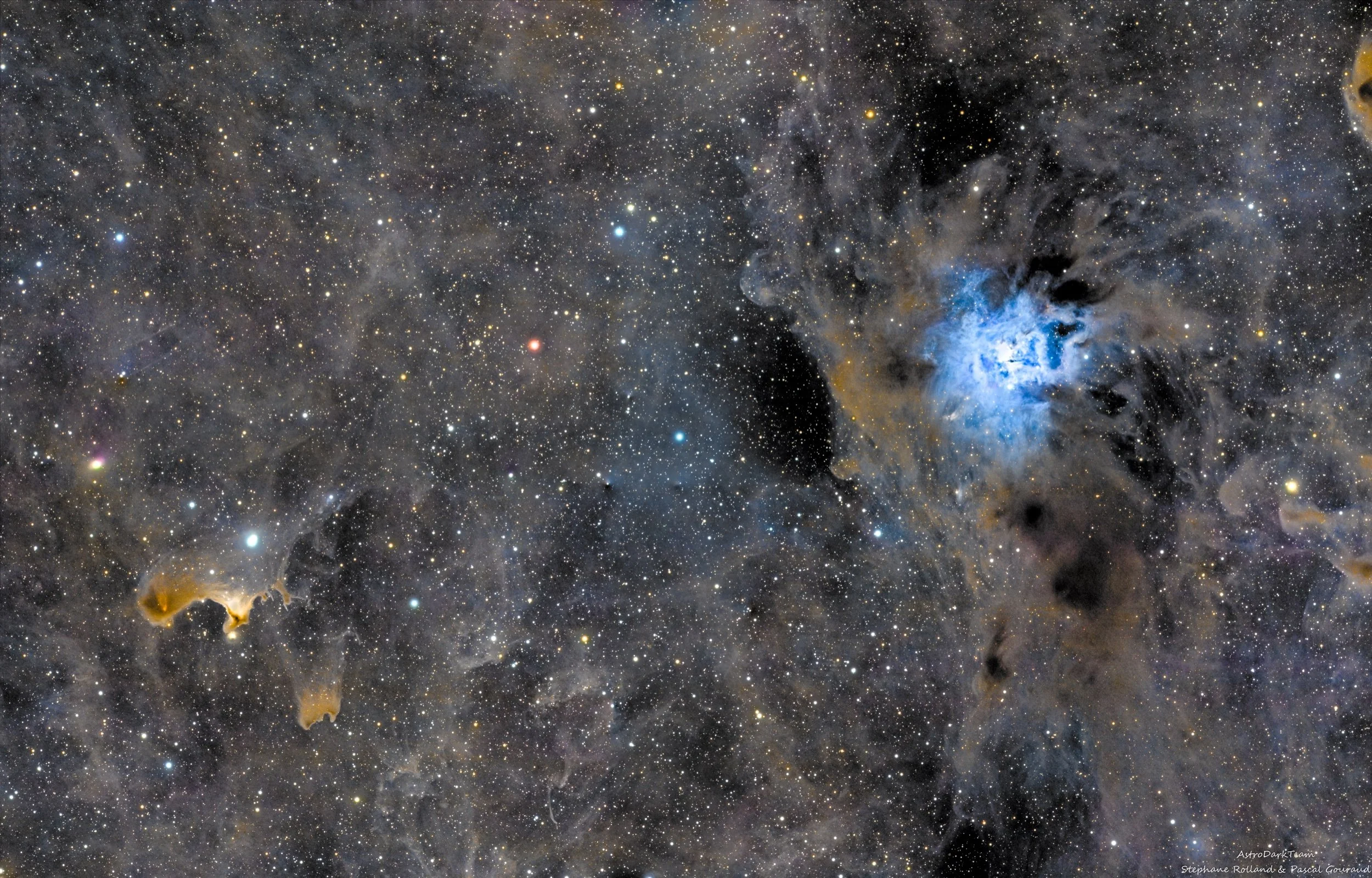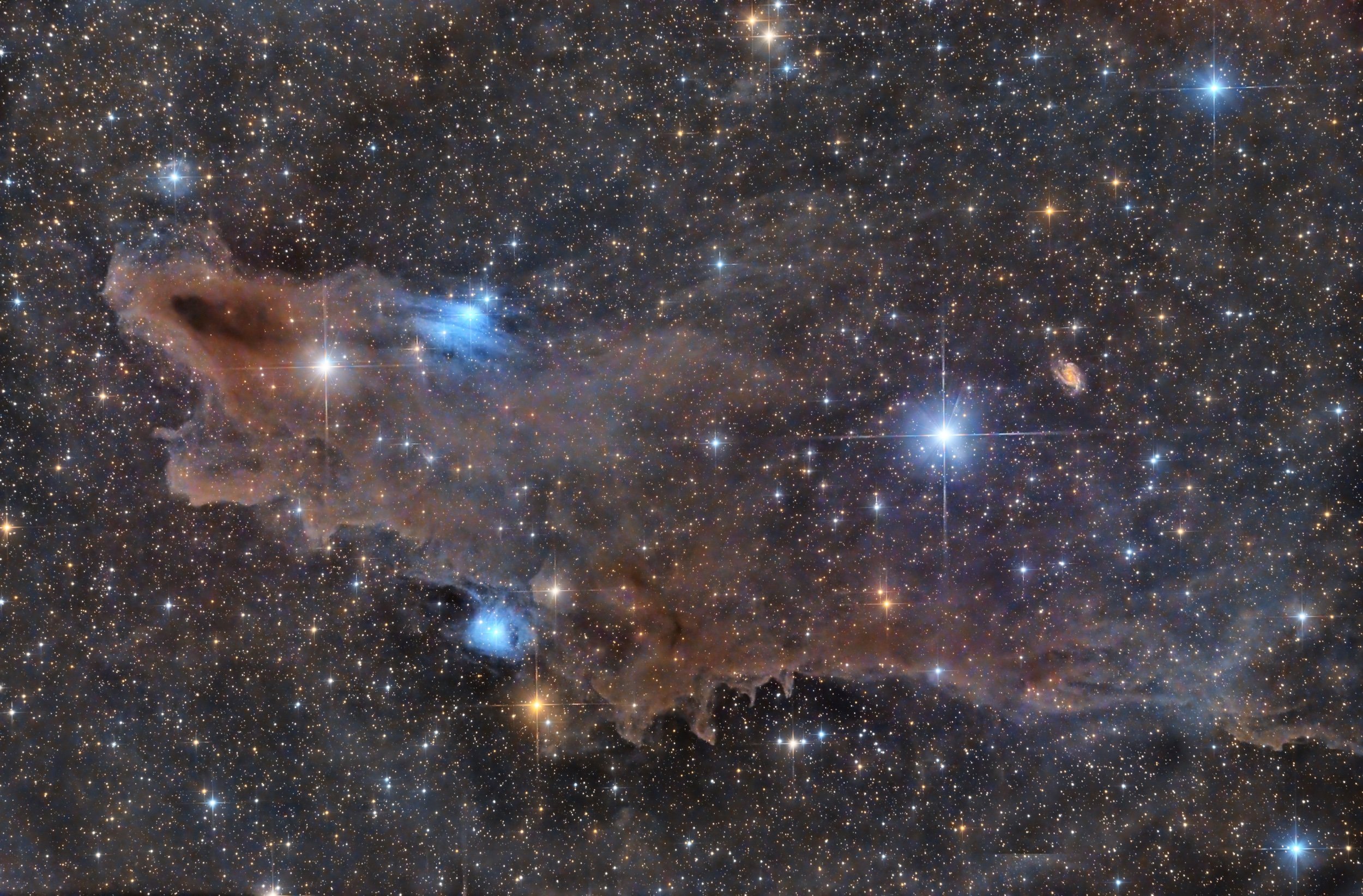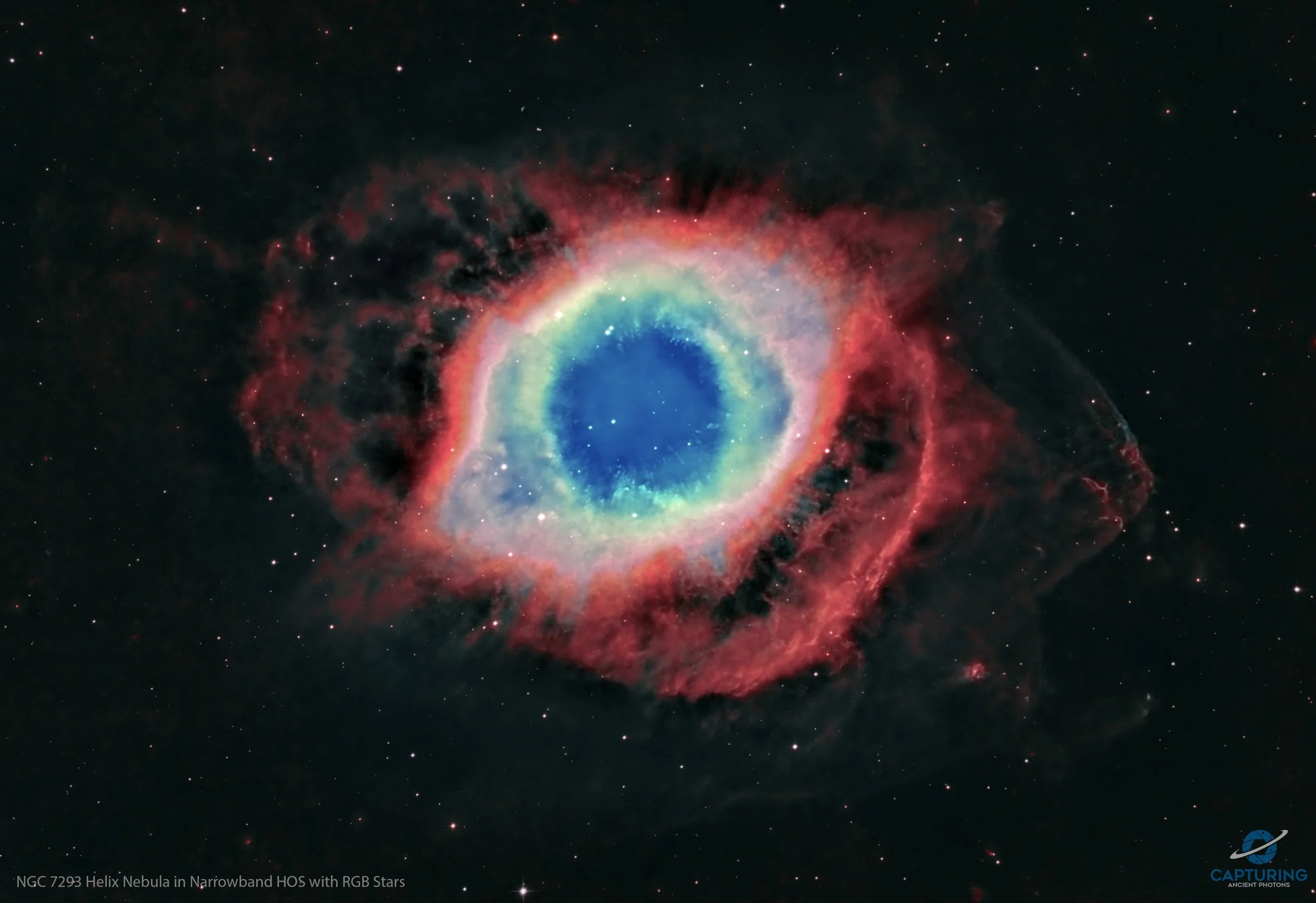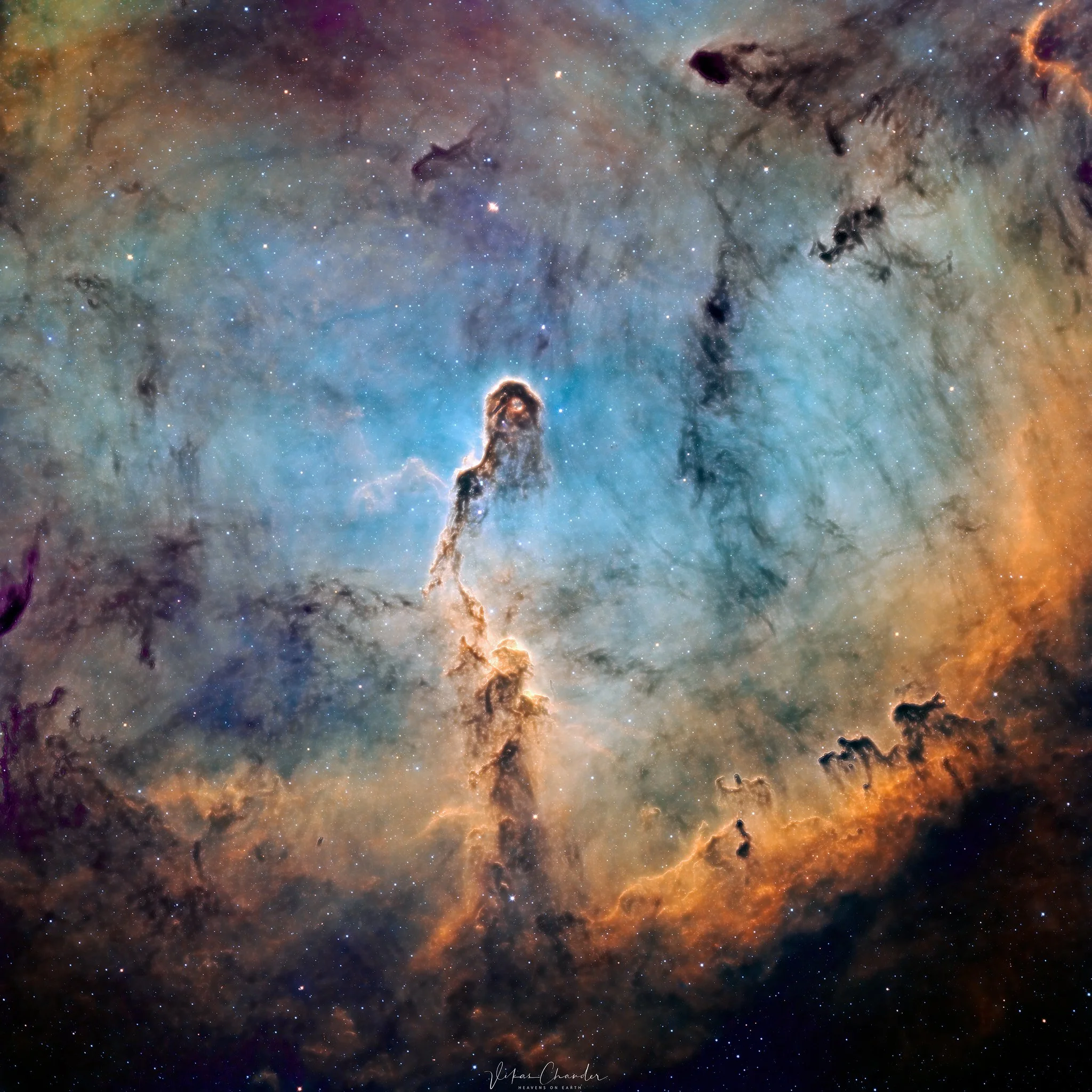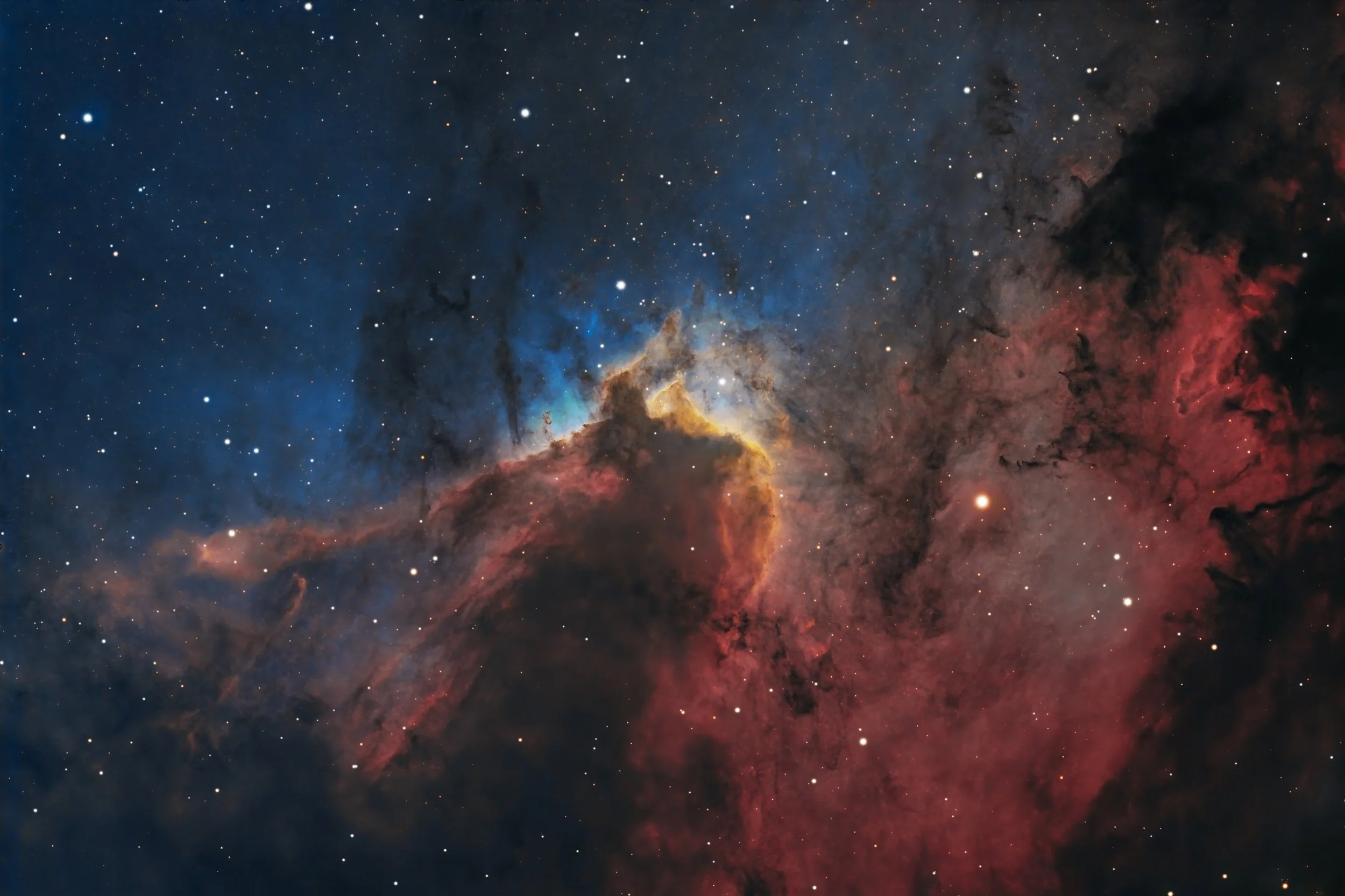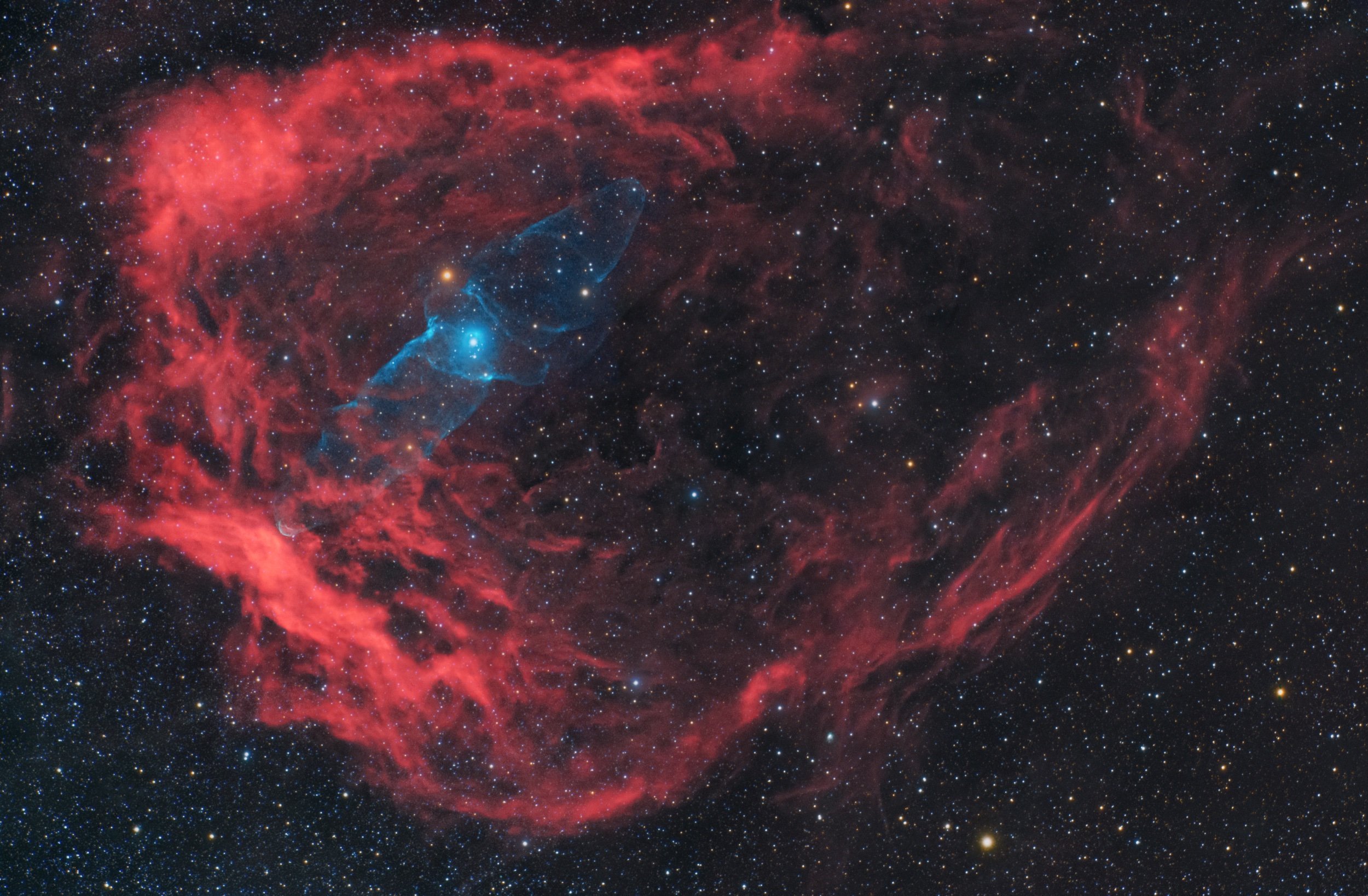
AAPOD2 Image Archives
NGC 7635: A bubble between clouds
Image Description and Details : My last image is a Bubble nebula (NGC 7635) with SHO narrowband channel and added RGB stars.
It is an emission nebula located in the constellation of Cassiopeia. The central bubble is one of three layers of hot gas surrounding the star SAO 20575, a very hot O6.5-class star. Curiously, this star (which is the one that heats the gas so that it emits light), due to its rapid movement, is not in the geometric center of the bubble. It is seen in the lower left area of the center of the bubble. It is a very young star (about 4 million years old...) and is expected to explode as a supernova in about 15 million years (more or less a million...). Interestingly, this nebula is located in a region where another supernova has already exploded.
It's great a lot of signal of SII, and aprecciate a large structures between bubble.
Tech data:
Halpha 25 of 900" astrodon 5nm
OIII 30 of 900" astrodon 5nm
SII 25 of 900" astrodon 5nm
RGB 25 each channel 120" astdodon
Telescope: Skywatcher Esprit 150
CCD: Atik 460ex
Mount: Paramount ME
Copyright: Carlos Uriarte Castilllo
Pleiades (M45)
Image Description and Details : Pleiades (M45)
Open Star Cluster
Magnitude: 1.6
Distance: 444 ly
Constellation: Taurus the Bull
A beautiful and mesmerizing deep sky objects that is etched on several folklores and mythology. This open star cluster is dominated by hot luminous B-Type stars that formed a 100 million years ago and is not gravitationally bound that will eventually drift apart. Pleiades stars are passing through a dust cloud and is completely unrelated reflection nebula. Scientist has found over a 1000 stars in the region. Pleiades is easy to find visually and is also a reference object in finding other deepsky targets.
SCT 8”, Hyperstar v4, ZWO(294MC Pro, ASIAR Pro, EAF) | EQ6R P
X120”- 5.77 hrs. | IDAS LPS D3
Gain: 100, -10 °C
APP, PS(Camera Raw + Plug-ins)
9/24-25/2022
Bortle 5 Ca, USA
Copyright: Paul Diosomito
WHTZ 1
Image Description and Details : WHTZ1 is an obscure, very faint but complex high-excitation planetary nebula in Aquila. It has a size of 193 arc seconds.
It was discovered by Ronald Weinberger, Herbert Hartl, Sonia Temporin and Caterina Zanin in 1999. It was also independently discovered by the French amateur astronomer Thierry Raffaelli in 2014 and is also known as Ra 7. It has also been discovered on two further separate occasions by the Deep Sky Hunters members Dana Patchick and Matthias Kronberger. The limb brightening visible towards its northern edge suggests interaction with the interstellar medium.
This is only the second time that it has been imaged - the previous image by the CHART32 team.
Data Capture: Sven Eklund and Peter Goodhew
Data calibration and integration: Sven Eklund
Image processing: Peter Goodhew
Data captured between 17 August - 22 September 2022.
Scopes: APM TMB LZOS 152 Refractors and Celestron C14 Edge HD
Cameras: QSI6120wsg8 and ZWO ASI6200MM Pro
Mounts: 10Micron GM2000 HPS and iOptron CEM120
A total of 68 hours 25 minutes (HaOIIIRGB)
Copyright: Copyright: Peter Goodhew, Sven Eklund
Pacman Revealed
Image Description and Details : NGC 281 - This awe inspiring emission nebula in Cassiopeia contains an open cluster accompanied with several Bok globules that appear to swim in a cosmic ocean rich in molecular hydrogen, sulfur and oxygen. Captured over several nights throughout late August and early September, more than 21 hours of the very best 12 minute subs were selected to reveal the exquisite detail in this mesmerizing region of the night sky.
Last year, I watched James Negri on the DSO Imager channel process this image. I was so impressed with James's image that I decided to add the Pacman Nebula to my list of objects to capture in 2022. The data was surprisingly clean and bright which was a pleasure to process.
Acquisition Details: Esprit 150ED, ASIAIR, ASI2600MM, EQ8-Rh Pro, Astronomik 6nm SHO filters, 720 second subs at Gain 100 under Bortle 5 skies.
Copyright: Copyright: David Jenkins
IC1396 - THE ELEPHANT'S TRUNK NEBULA
Image Description and Details : 🔭 TS-Optics 76EDPH
📷 ZWO ASI2600MM Pro
⚙ SkyWatcher AZEQ6
🔵Antlia SHORVB pro 36mm
Images unitaires:
Antlia Ha 3.0nm pro 36mm: 5h
Antlia OIII 3nm Pro 36mm: 5h25
antlia SII 3.0 nm Pro 36mm: 5h35
💻: NINA · Adobe Inc Photoshop CC · Pleiades AstroPhoto PixInsight
Copyright: Astromac
The green waterfall
Image Description and Details : The auroras were so big and bright that it actually lightened up the landscape so that you could see where to walk without the need of a flashlight. It helped me a bit to move on the wet, slippery rocks without dying.
Sony FE 14mm f/1.8 GM
Sony A7S
ISO 5000
0,5 seconds
Minor adjustments in adobe photoshop
Copyright: Dennis Lehtonen
OU4
Image Details:
so here's my latest take, it's SH2-129 - OU4, known as:
- SH2-129 Bat Nebula in flight and
- OU4 giant squid nebula, discovered by French amateur astronomer Nicolas Outters.
- For this treatment, I wanted to keep some transparency from the squid, allowing the gases in the background to be distinguished, which gives a sense of depth.
- I also preferred a gentle treatment on the whole Squid to avoid a cupboard thing in the picture as well.
Copyright: Emmanuel Tesnieres
LBN552
Image Description and Details : Molecular cloud complex LBN 552 LNB 550 LBN 555 and LDN 1228 in the constellation Cepheus
Molecular clouds LBN 552 and LDN 1228 consist mostly of a diffuse dark nebula, which were cataloged by Beverly T. Lynds in 1965 as LDN 1228 or LBN 552.
50 exposures on each RGB filter and 230 exposures in Luminance of 5 minutes.
Total 31H40
Askar FRA 600 bezel
Reducer 0.79
420mm focal length at F3.9
EQ6 Pro Mount
Orion Starguider Mini Scope Autoguider
Camera Starshoot Autoguider
ZWO ASI2600MM Pro Imager
ZWO 7*36MM Filter Wheel
Baader filter L, R, G, B, S2, Ha and O3
Sky Quality 19.95
Magnitude CLASS 5 Bortle
SGP SEQUENCE GENERATOR PRO, SIRIL and UWE ASTRO TOOLS
Copyright: (c)2022 Uwe KAMIN
Sharpless 2-54
Image Description and Details :
Sharpless 2-54 or RCW 167 / Gum 84 is a large bright nebula complex close to familiar targets M16 (Eagle Nebula) and M17 (Swan Nebula) in the constellation of Serpens.
42 x 600s subs shot @-10C taken over 4 nights for an integration time of 7 hours.
Equipment used:
Skywatcher 10" f4 Newtonian 250P
Skywatcher F4 Aplanatic Coma Corrector
Skywatcher NEQ6 Pro Hypertuned by Astronomy Academy Perth
ZWO ASI2600MM Pro Cooled Camera
Primaluce Sesto Senso2 Electronic Focuser
William Optics Uniguide 50/200mm guidescope
ZWO ASI290MM Mini Guide Camera
ZWO Electronic Filter Wheel
Antlia Pro 36mm unmounted filters
Rollon rolloff modified shed observatory
Bortle 5
Data acquisition software: NINA Astronomy Software
Processing software: PixInsight and Photoshop CC
Copyright: Capturing Ancient Photons
Ngc 1097
NGC 1097 is a barred spiral galaxy 50 million light years away in Fornax.
There are a number of interesting features
The galaxy contains a super massive black hole 140 million times greater than our sun. The black hole is surrounded by a ring with numerous areas of star formation. The ring is lit by an influx of material moving towards the central bar of the galaxy.
The galaxy contains four optical jets (one of which is extremely faint) that seem to emanate from the nucleus region. Studies have determined the jets are not emissions but are made up of stars.
There are two satellite galaxies NGC 1097 A and B. A is a peculiar galaxy which is orbiting only 42000 light years from the center of NGC 1097 while B is a dwarf galaxy which was discovered by emissions and has not been well studied.
Imaged in LRGB and H alpha on our CDK 1000 at Observatorio El Sauce, Chile
Image Processing: Mike Selby and Mark Hanson
Heart & soul
Here is the Heart and Soul area as a mosaic using One Click Observations, Advanced Requests, and some lum data I had to put this mosaic together. Used APP and Photoshop to process this out. A total of 550 600s and 148 300s, split between Ha, Oiii and Sii with some luminance in there. This is cropped too! Telescope was a Takahashi FSQ106, camera FLI PL16083, filters Astrodon 3nm SHO and Gen IIe lum.
Copyright: Scotty Bishop
Iris and Ghost Nebula + IFN mosaic
Image Description and Details : Our fifth sky target, a wide field of 4 tiles in the constellation Cepheus with the Iris Nebula (NGC7023) and the Ghost Nebula (VDB141). To date, it remains our most ambitious and complex project in terms of acquisition and processing.
This constellation Cepheus in the Milky Way is sublime because it is dotted with bright and dark nebulae, which show superb colors and contrasts. In addition, many molecular clouds (IFN) line the constellation forming coffee-colored arabesques.
The full image corresponds to a mosaic of four tiles (with LRGB layers), which represents a total of 90 hours of exposures over approximately 35 nights, including 50 hours in Luminance (around 12 hours per tile) and 40 hours in RGB ( therefore 10 hours per tile).
Two crops were produced on L'Iris and le Fantôme.
Technical Details
250 exposures for each field, of 3 minutes in Luminance
215 exposures for each field, of 3 minutes, for the 3 RGB filters
Takahashi TOA telescope 130mm in diameter, 1000mm focal length
Moonlite Nightcrawler 35 focuser/rotator
ASI2600MM monochrome camera cooled to -10 degrees
ZWO filter wheel with 36mm Chroma LRGB filters
Autoguiding optical splitter ZWO with Camera ASI290MM
EQ8-R Mount
Software Maxpilote, The Sky X Pro, FocusMax V3
Pixinsight, Adobe Lightroom/Photoshop processing
Dates: between 28/05/2022 and 9/08/2022 (about 35 nights)
Copyright: Stephane Rolland and Pascal Gouraud (AstroDarkTeam)
LBN 468
Image Description and Details :
LBN468, Dark nebula at 1.600 light years away, between the constellations of Cepheus and Draco
23/08/2022, 26/08/2022, 28/08/2022 in Naharros, Cuenca; Spain.
55x600" Lum. bin1
19x300" Red bin2
30x300" Green bin2
25x300" Blue bin2
SW ESPRIT 100ED
Reducer x0,75 Riccardi
Atik 460ex Mono
Copyright: Cesar Agudo
Shark nebula
Image Description and Details : The Shark Nebula is a deepsky object I've tried to image a few times and never had much success. It is faint and challenging both in acquisition and processing. It requires a lot of moonless nights to really make the nebula region pop and to bring out the colours. This latest attempt to image it I employed different equipment than I usually use. For years I've used refractors to image the night sky but for the Shark nebula project I used a Starfield Optics 8 inch astrograph with a Starizona reducer/corrector which makes it an F3 light collecting beast! This combination worked very well on this target and I'm really happy with the final image. There is a lot to see in this image including LDN1235, VDB 149, VDB150 and galaxy PGC 67671. It's an interesting region of interstellar gas and dust sculpted by massive stars and their fast stellar winds and light energy.
Imaging location: Kitchener, Ontario, Canada
Equipment:
Starfield Optics 8in astrograph
Starizona Nexus reducer/corrector for F3
QHY268M cmos camera and filter wheel
Optolong LRGB filters
Skywatcher EQ6 mount
Skyshed Pier
Acquisition NINA 2.0
Processed in PixInsight
Exposure time: 17.5 hours (1min subs at high gain)
Copyright: Shawn Nielsen | VisibleDark
NGC 7293 Helix Nebula 'Eye of God'
Image Description and Details : Added another 12 hours of data to this awesome target NGC 7293 or more commonly known as the Helix Nebula or Eye of God or Eye of Sauron is a planetary nebula formed by the expanding shell of glowing gas around a dying low-mass star. It is located in the constellation Aquarius and is about 650 light-years away with a diameter of about 2.5 light-years.
33 x 20min and 147 x 5min SHO and 28 x 3min RGB subs shot @-10C taken over 9 nights for an integration time of about 24.5 hours.
Equipment used:
Skywatcher 10" f4 Newtonian 250P
Skywatcher F4 Aplanatic Coma Corrector
Skywatcher NEQ6 Pro Hypertuned by Astronomy Academy Perth
ZWO ASI2600MM Pro Cooled Camera
Primaluce Sesto Senso2 Electronic Focuser
William Optics Uniguide 50/200mm guidescope
ZWO ASI290MM Mini Guide Camera
ZWO Electronic Filter Wheel
Antlia Pro 36mm unmounted filters
Rollon rolloff modified shed observatory
Bortle 5
Data acquisition software: NINA Astronomy Software
Processing software: PixInsight and Photoshop CC
Copyright: Capturing Ancient Photons
Name: Carlos Taylor
Elephants Trunk Nebula
Image Description and Details : The Elephant's Trunk nebula is a concentration of interstellar gas and dust located in the constellation Cepheus about 2,400 light years away from Earth. The Elephant's Trunk is composed of cool interstellar dust and gas, which blocks out light on its way to Earth and leaves behind a long, thin silhouette that gives the nebula its name, and makes it one of many nebulae that look like animals. Imaged here in what is known as the Hubble palette of colours on can clear make out the many gases which form this very interesting deep sky object….
Telescope: Orion Optics AG14
Camera: FLI Kepler Gsense 4040
Mount: 10 Micron Gm 2000
Observatory : Roboscopes
Sii = 70 x 120s
Ha = 48 x 120s
Oiii = 48 x 180s
Total integration = 6h20m
Software = PixInsight
Copyright: vikas chander
Mosaic NGC5078, NGC5101 and friends in Hydra
Image Description and Details:
ATRIA Team composed of 6 members : Olivier, Fabien , Frédéric . David , Julien , and myself ;-)
----------------------------------
Panel of 2 images with the CDK17
Image 1
Red 30subs@420s -15°C gain high
Green 32 subs@300s -15°C gain high
Blue 42subs@300s -15°C gain high
Light 464subs@180s -15°C, gain high
Exposition : 32h 28'
Image 2
Red 24 subs@420s -15°C gain high
Green 20 subs@300s -15°C gain high
Blue 20 subs@300s -15°C gain high
Light 454 subs@180s -15°C, gain high
Exposition : 28h 50'
Total exposition 61h14'
Copyright: Arnaud PEEL
Venturing into the Cave
Image Description and Details : This August, we have been fortunate to have had many clear nights up in Southwestern Ontario Canada. This mysterious looking target has been on my list for a while. Instead of capturing a widefield image, I chose to get close to reveal the faint detail surrounding this nebula. I processed the data in both SHO and HOO and then blended them together to create a unique and rich colour palette.
Copyright: David Jenkins
Sh2-129 & Ou4
Image Description and Details : Sh2-129, also known as the Bat Flight Nebula, is a region of HII-type nebula emission located about 1,300 light-years from Earth in the constellation Cepheus. We can see another nebula, the Squid Nebula (Ou4), located at a distance of about 2300. It is a very weak nebula and requires many hours of integration to be able to appreciate it.
75 x 600" Ha Gain 56 -5º
100 x 600" OIII Gain 56 -5º
50 x 120" Red Gain 56 -5º
50 x 120" Green Gain 56 -5º
50 x 120" Blue Gain 56 -5º
35 Hours
Qhy268m Camera
Esprit 100
Eq6r-Pro
From Ager, Lleida, Spain
Remote Observatory
Copyright: Toni Fabiani

